英汉语言文化比较期末重点
翻译英汉语言文化对比 汇总
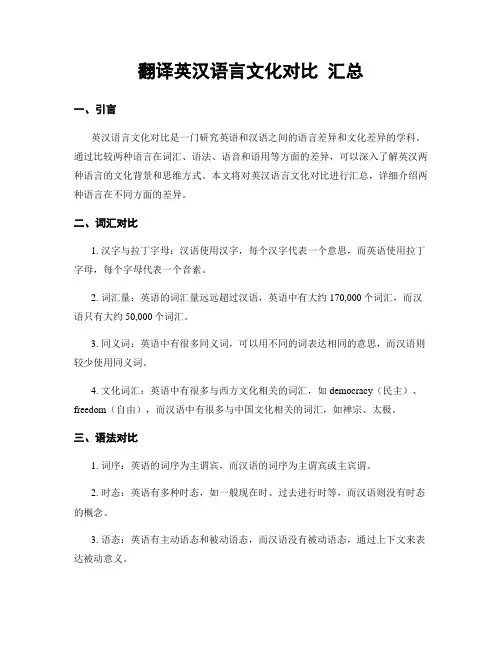
翻译英汉语言文化对比汇总一、引言英汉语言文化对比是一门研究英语和汉语之间的语言差异和文化差异的学科。
通过比较两种语言在词汇、语法、语音和语用等方面的差异,可以深入了解英汉两种语言的文化背景和思维方式。
本文将对英汉语言文化对比进行汇总,详细介绍两种语言在不同方面的差异。
二、词汇对比1. 汉字与拉丁字母:汉语使用汉字,每个汉字代表一个意思,而英语使用拉丁字母,每个字母代表一个音素。
2. 词汇量:英语的词汇量远远超过汉语,英语中有大约170,000个词汇,而汉语只有大约50,000个词汇。
3. 同义词:英语中有很多同义词,可以用不同的词表达相同的意思,而汉语则较少使用同义词。
4. 文化词汇:英语中有很多与西方文化相关的词汇,如democracy(民主)、freedom(自由),而汉语中有很多与中国文化相关的词汇,如禅宗、太极。
三、语法对比1. 词序:英语的词序为主谓宾,而汉语的词序为主谓宾或主宾谓。
2. 时态:英语有多种时态,如一般现在时、过去进行时等,而汉语则没有时态的概念。
3. 语态:英语有主动语态和被动语态,而汉语没有被动语态,通过上下文来表达被动意义。
4. 冠词:英语中有冠词a/an和the,用于限定名词,而汉语没有冠词。
5. 代词:英语中有主格、宾格、所有格等代词形式,而汉语的代词形式相对简单。
四、语音对比1. 音素:英语有大约44个音素,而汉语有大约21个音素。
2. 音调:汉语是一种声调语言,有四个基本的声调,而英语则没有声调。
3. 发音规则:英语的发音规则相对复杂,存在很多不规则发音,而汉语的发音规则相对简单。
五、语用对比1. 礼貌用语:英语注重礼貌用语的使用,如please(请)、thank you(谢谢),而汉语注重尊称的使用,如先生、女士。
2. 谦虚语气:英语中常使用谦虚语气来表示客套和礼貌,如I'm sorry(对不起),而汉语则较少使用谦虚语气。
3. 文化差异:英语和汉语的语用差异也反映了两种文化的差异,如英语中的直接表达和汉语中的间接表达。
从语言学角度对比中英语言文化差异
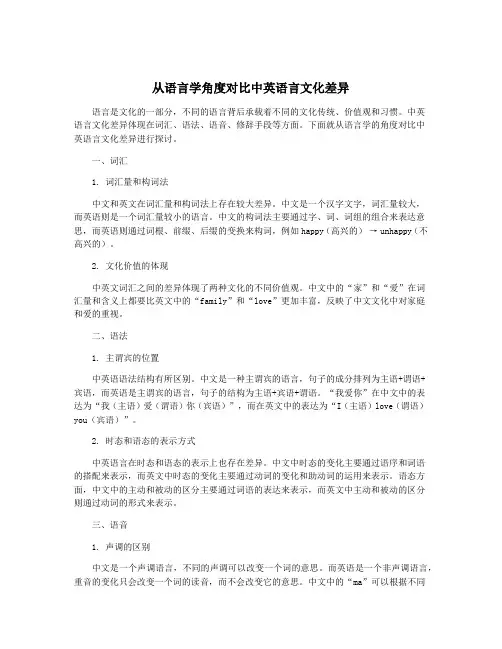
从语言学角度对比中英语言文化差异语言是文化的一部分,不同的语言背后承载着不同的文化传统、价值观和习惯。
中英语言文化差异体现在词汇、语法、语音、修辞手段等方面。
下面就从语言学的角度对比中英语言文化差异进行探讨。
一、词汇1. 词汇量和构词法中文和英文在词汇量和构词法上存在较大差异。
中文是一个汉字文字,词汇量较大,而英语则是一个词汇量较小的语言。
中文的构词法主要通过字、词、词组的组合来表达意思,而英语则通过词根、前缀、后缀的变换来构词,例如happy(高兴的)→ unhappy(不高兴的)。
2. 文化价值的体现中英文词汇之间的差异体现了两种文化的不同价值观。
中文中的“家”和“爱”在词汇量和含义上都要比英文中的“family”和“love”更加丰富,反映了中文文化中对家庭和爱的重视。
二、语法1. 主谓宾的位置中英语语法结构有所区别。
中文是一种主谓宾的语言,句子的成分排列为主语+谓语+宾语,而英语是主谓宾的语言,句子的结构为主语+宾语+谓语。
“我爱你”在中文中的表达为“我(主语)爱(谓语)你(宾语)”,而在英文中的表达为“I(主语)love(谓语)you(宾语)”。
2. 时态和语态的表示方式中英语言在时态和语态的表示上也存在差异。
中文中时态的变化主要通过语序和词语的搭配来表示,而英文中时态的变化主要通过动词的变化和助动词的运用来表示。
语态方面,中文中的主动和被动的区分主要通过词语的表达来表示,而英文中主动和被动的区分则通过动词的形式来表示。
三、语音1. 声调的区别中文是一个声调语言,不同的声调可以改变一个词的意思。
而英语是一个非声调语言,重音的变化只会改变一个词的读音,而不会改变它的意思。
中文中的“ma”可以根据不同的声调分别表示“妈”、“麻”、“马”、“吗”等不同的意思,而英语中的“ma”只有一个读音,不会改变它的意思。
2. 元音和辅音的差异中英语言在元音和辅音上存在一定的差异。
中文的元音比较丰富,有多种单元音和复元音,而英文的元音比较简单,只有一些常见的单元音和复元音。
英汉语言对比复习资料
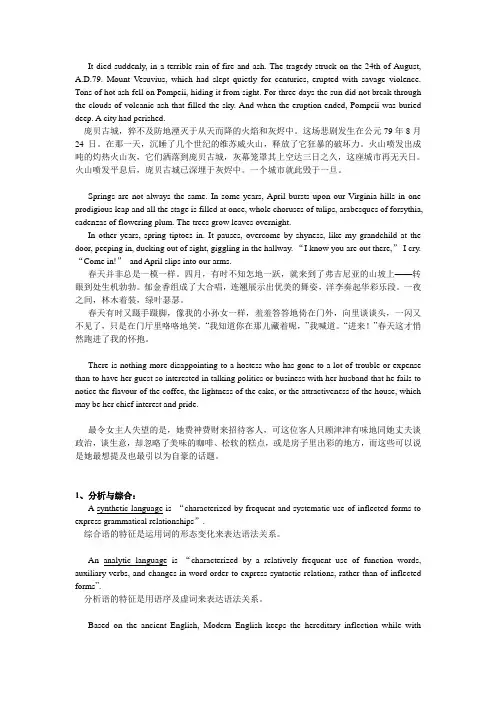
It died suddenly, in a terrible rain of fire and ash. The tragedy struck on the 24th of August, A.D.79. Mount Vesuvius, which had slept quietly for centuries, erupted with savage violence. Tons of hot ash fell on Pompeii, hiding it from sight. For three days the sun did not break through the clouds of volcanic ash that filled the sky. And when the eruption ended, Pompeii was buried deep. A city had perished.庞贝古城,猝不及防地湮灭于从天而降的火焰和灰烬中。
这场悲剧发生在公元79年8月24日。
在那一天,沉睡了几个世纪的维苏威火山,释放了它狂暴的破坏力。
火山喷发出成吨的灼热火山灰,它们洒落到庞贝古城,灰幕笼罩其上空达三日之久,这座城市再无天日。
火山喷发平息后,庞贝古城已深埋于灰烬中。
一个城市就此毁于一旦。
Springs are not always the same. In some years, April bursts upon our Virginia hills in one prodigious leap and all the stage is filled at once, whole choruses of tulips, arabesques of forsythia, cadenzas of flowering plum. The trees grow leaves overnight.In other years, spring tiptoes in. It pauses, overcome by shyness, like my grandchild at the door, peeping in, ducking out of sight, giggling in the hallway. “I know you are out there,”I cry. “Come in!”and April slips into our arms.春天并非总是一模一样。
从语言学角度对比中英语言文化差异
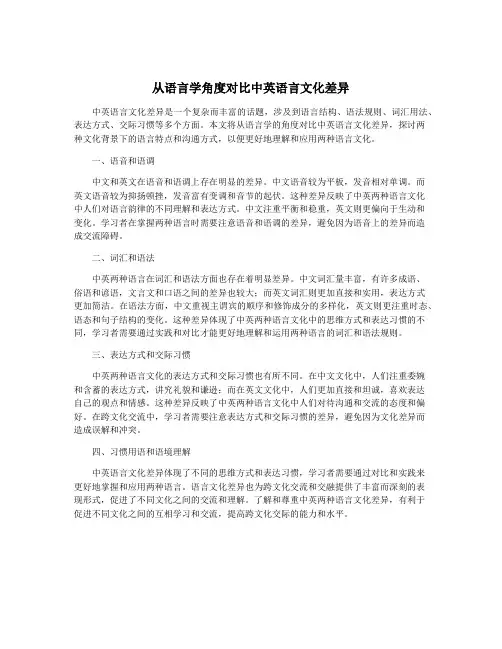
从语言学角度对比中英语言文化差异中英语言文化差异是一个复杂而丰富的话题,涉及到语言结构、语法规则、词汇用法、表达方式、交际习惯等多个方面。
本文将从语言学的角度对比中英语言文化差异,探讨两种文化背景下的语言特点和沟通方式,以便更好地理解和应用两种语言文化。
一、语音和语调中文和英文在语音和语调上存在明显的差异。
中文语音较为平板,发音相对单调。
而英文语音较为抑扬顿挫,发音富有变调和音节的起伏。
这种差异反映了中英两种语言文化中人们对语言韵律的不同理解和表达方式。
中文注重平衡和稳重,英文则更偏向于生动和变化。
学习者在掌握两种语言时需要注意语音和语调的差异,避免因为语音上的差异而造成交流障碍。
二、词汇和语法中英两种语言在词汇和语法方面也存在着明显差异。
中文词汇量丰富,有许多成语、俗语和谚语,文言文和口语之间的差异也较大;而英文词汇则更加直接和实用,表达方式更加简洁。
在语法方面,中文重视主谓宾的顺序和修饰成分的多样化,英文则更注重时态、语态和句子结构的变化。
这种差异体现了中英两种语言文化中的思维方式和表达习惯的不同,学习者需要通过实践和对比才能更好地理解和运用两种语言的词汇和语法规则。
三、表达方式和交际习惯中英两种语言文化的表达方式和交际习惯也有所不同。
在中文文化中,人们注重委婉和含蓄的表达方式,讲究礼貌和谦逊;而在英文文化中,人们更加直接和坦诚,喜欢表达自己的观点和情感。
这种差异反映了中英两种语言文化中人们对待沟通和交流的态度和偏好。
在跨文化交流中,学习者需要注意表达方式和交际习惯的差异,避免因为文化差异而造成误解和冲突。
四、习惯用语和语境理解中英语言文化差异体现了不同的思维方式和表达习惯,学习者需要通过对比和实践来更好地掌握和应用两种语言。
语言文化差异也为跨文化交流和交融提供了丰富而深刻的表现形式,促进了不同文化之间的交流和理解。
了解和尊重中英两种语言文化差异,有利于促进不同文化之间的互相学习和交流,提高跨文化交际的能力和水平。
《汉英语言比较》复习提纲
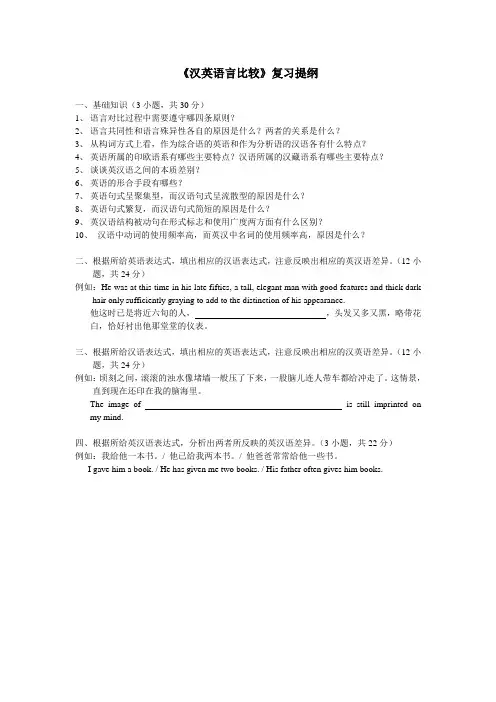
《汉英语言比较》复习提纲一、基础知识(3小题,共30分)1、语言对比过程中需要遵守哪四条原则?2、语言共同性和语言殊异性各自的原因是什么?两者的关系是什么?3、从构词方式上看,作为综合语的英语和作为分析语的汉语各有什么特点?4、英语所属的印欧语系有哪些主要特点?汉语所属的汉藏语系有哪些主要特点?5、谈谈英汉语之间的本质差别?6、英语的形合手段有哪些?7、英语句式呈聚集型,而汉语句式呈流散型的原因是什么?8、英语句式繁复,而汉语句式简短的原因是什么?9、英汉语结构被动句在形式标志和使用广度两方面有什么区别?10、汉语中动词的使用频率高,而英汉中名词的使用频率高,原因是什么?二、根据所给英语表达式,填出相应的汉语表达式,注意反映出相应的英汉语差异。
(12小题,共24分)例如:He was at this time in his late fifties, a tall, elegant man with good features and thick dark hair only sufficiently graying to add to the distinction of his appearance.他这时已是将近六旬的人,,头发又多又黑,略带花白,恰好衬出他那堂堂的仪表。
三、根据所给汉语表达式,填出相应的英语表达式,注意反映出相应的汉英语差异。
(12小题,共24分)例如:顷刻之间,滚滚的浊水像堵墙一般压了下来,一股脑儿连人带车都给冲走了。
这情景,直到现在还印在我的脑海里。
The image of is still imprinted on my mind.四、根据所给英汉语表达式,分析出两者所反映的英汉语差异。
(3小题,共22分)例如:我给他一本书。
/ 他已给我两本书。
/ 他爸爸常常给他一些书。
I gave him a book. / He has given me two books. / His father often gives him books.。
英汉语言文化比较期末重点
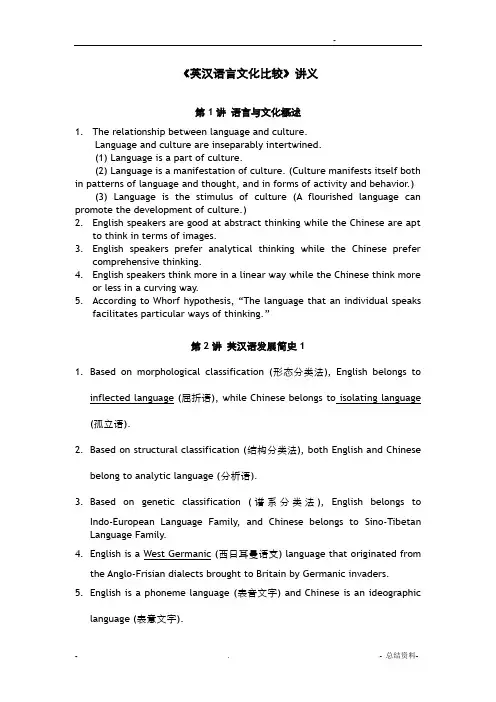
《英汉语言文化比较》讲义第1讲语言与文化概述1.The relationship between language and culture.Language and culture are inseparably intertwined.(1) Language is a part of culture.(2) Language is a manifestation of culture. (Culture manifests itself both in patterns of language and thought, and in forms of activity and behavior.)(3) Language is the stimulus of culture (A flourished language can promote the development of culture.)2.English speakers are good at abstract thinking while the Chinese are aptto think in terms of images.3.English speakers prefer analytical thinking while the Chinese prefercomprehensive thinking.4.English speakers think more in a linear way while the Chinese think moreor less in a curving way.5.According to Whorf hypothesis, “The language that an individual speaksfacilitates particular ways of thinking.”第2讲英汉语发展简史11.Based on morphological classification (形态分类法), English belongs toinflected language (屈折语), while Chinese belongs to isolating language (孤立语).2.Based on structural classification (结构分类法), both English and Chinesebelong to analytic language (分析语).3.Based on genetic classification (谱系分类法), English belongs toIndo-European Language Family, and Chinese belongs to Sino-Tibetan Language Family.4.English is a West Germanic (西日耳曼语支) language that originated fromthe Anglo-Frisian dialects brought to Britain by Germanic invaders.5.English is a phoneme language (表音文字) and Chinese is an ideographiclanguage (表意文字).6.The first people in England about whose language we have definiteknowledge are the Celts.7.After the Norman Conquest, English entered the period of Middle English.8.The period from 450 to 1150 is known as Old English. From 1150 to 1500the language is known as Middle English. The language since 1500 is called Modern English (1500-1700, early Modern English, 1700 until now, later Modern English).9.The main differences between Chinese words and English words: a)Letters in English are like strokes in Chinese. b) Morphemes in English are like radicals in Chinese. c) Chinese associative compounds (会意字) are like English compound words.第3讲英汉语发展简史21.Chinese and most related languages share features that make them unlikemost Western languages: They are monosyllabic, have even less inflection than English, and are tonal.2.In Chinese, a syllabic structure has three essential components: initials(声母), finals (韵母), and tones (声调). Chinese pinyin system has 21 initial consonants, 36 final vowels and 4 tones.3.According to Xu Shen’s (许慎) research, Chinese characters can be dividedinto six groups: 1) Pictographs (≈4%) 象形; 2) Ideographs (≈1%) 指事; 3) Logical Aggregates (≈13%) 会意; 4) Phonetic Complexes (≈82%) 形声; 5) Associative Transformations (a small portion) 转注; 6) Borrowings (a small portion) 假借.第4讲英汉语构词法1.Word formation in English:1)Compounding (合成法): T wo or more words are joined together toform a new word. (For example: home + work →homework)2)Prefixation (前缀法): Prefixation is the formation of new words byadding prefixes to stems. Prefixes do not generally change the word-class of the stem but only modify its meaning. (For example:Pejorative prefixes (贬义前缀): mal-, pseudo-, mis-, ill-).3)Suffixation (后缀法): Suffixation is the formation of new words byadding suffixes to stems. Unlike prefixes which primarily change the meaning of the stem, the primary function of suffixes is to change the grammatical function of stems.4)Conversion (转化法): Conversion is a word-formation whereby a wordof a certain word-class is shifted into a word of another without the addition of an affix. It is also called zero derivation (零位派生). (For example: 1) Problems snowballed by the hour. 2) Sandwich the two bread halves together and cut into 1-inch-wide slices.)5)Shortening (缩略法)6)Blending (拼缀法): Blending is a process of word-formation in which anew word is formed by combining parts of two words. The result of such a process is called a blend. Blending is a process of both compounding and abbreviation. For example, smog (smoke+fog).7)Back-formation (逆成法): a process of word-formation by which aword is created by the deletion of a supposed suffix. It is also known as a reverse derivation.8)Eponyms9)T oponyms2.Word formation in Chinese:1)The overwhelming majority of the Old-Chinese morphemes aremono-syllabic.2)61% of the 3,000 most commonly used Chinese words are disyllabic.3)Chinese prefixes mostly involve morphemes such as 老, 小, 第, and初.4)Some so-called Chinese suffixes are added as a way of nominalization,like 度, 性, etc.第5讲英汉词语的文化涵比较11.In Chinese, the word xīn (心) that primarily denotes the heart organ mayalso refer to the “organ for thinking”and the “seat of thought and emotions”.2.In contrast, according to the Western view, heart is seen as the center ofemotions/feelings and the head (the locus of the brain with which the mind is associated) as the center of thought.3.Based on the metaphor “heart as a physical entity”, the following wordsare formed in Chinese: 心房, 心窝, 心田, 心地, and 心弦.4.Research proves that if a language only has two color words, they must beblack and white; if the language has the third color word, it must be red;if it has the fourth one, it must be yellow or green.第6讲英汉词语的文化涵比较21.Dog has a negative connotation in “a dog in the manger”.2.Traditionally, people have talked about “fixed expressions”, stressing thefixedness of these expressions, but corpus studies have shown that many of the phrases can actually be varied.3.An idiom is a fixed or semi-fixed expression whose meaning cannot bededuced from its parts. But very few idioms are 100% fixed.第7讲英语抽象名词和汉语具体名词1.The plural forms of abstract English nouns often have the function ofconcretization, for example, ratings, attractions and breakdowns.第8讲形合与意合1.Hypotaxis (形合): The dependent or subordinate relationship of clauseswith connectives. For example: It was cold because the snows came.2.Parataxis (意合): The arranging of clauses or phrases without connectivesshowing the relations between them. For example: It was cold; the snows came.第9讲英汉句法比较1. A topic-prominent language is a language that organizes its syntax toemphasize the topic–comment structure of the sentence. Chinese is considered to be a topic-prominent language, where the topic of the sentence takes precedence in the sentence.2. A subject-prominent language (e.g. English) is a language in which thegrammatical units of subject and predicate (S V) are basic to thestructure of sentences and in which sentences usually have subject-predicate structure.第10讲英语被动句和汉语主动句1.English uses far more passive sentences than Chinese./ Passive voicesentences are more common in English than in Chinese.2.Many sentences in English have inanimate/impersonal subjects (无灵主语),while Chinese use this pattern less frequently. For example, “The thick carpet on the corridor killed the sound of my footsteps.”第11讲语篇对比11.According to Halliday and Hasan, collocation is “cohesion that is achievedthrough the association of lexical items that regularly co-occur”. The association is achieved when the lexical items have a tendency to appear in similar lexical environments or when they are related lexicosemantically.2.a) This is a fine hall you have here. I’m proud to be lecturing in it.(Reference)b) This is a fine hall you have here. I’ve never lectured in a finer one.(Substitution)c) This is a fine hall you have here. I’ve never lectured in a finer. (Ellipsis)第12讲语篇对比21.The normal pattern to develop an English paragraph: topic sentence (mainpoint/ central thought) – supporting details.第13讲隐喻、文化和世界观1.Sports metaphors are used by all Americans, regardless of class,professions, race, age or gender. The reasons are as follows:1)Most Americans believe competition to be one quality that has madeAmerica great.2)“Being the best” American mentality has often turned everyday lifeinto a sport game. People compete in almost everything.3)American schools are another contributing factor to the Americansports mania. In many schools, athletics outweighs all other programsin terms of money and attention received.4)As a country, from the national to the local level, Americans go out oftheir way to honor athletes.2.The literal use of 吃includes 吃面, 吃饭. (not吃惊, 吃香, 吃官司, 吃败仗). The literal use of 吃饭includes 吃冷饭. (not 吃干饭, 吃闲饭, 吃软饭)第14讲基于语料库的英汉语比较与翻译考察1.Corpus (pl. corpora or corpuses): a collection of text, now usually inmachine-readable form and compiled to be representative of a particular kind of language and often provided with some kind of annotation.2.Parallel corpus is most useful for translation studies.第15讲个人主义与集体主义1.Highly individualistic cultures include the U.S., Australia, Great Britain,Canada, the Netherlands, New Zealand, and Italy. Some examples of collectivist cultures include India, Japan and China.Short Answer Questions:1.What are the different types of transliterations (音译)? Give theChinese borrowings from English as examples.Answer: The first type is phonetic loans: 摩登、咖啡、咖喱、巧克力、克隆。
《中英语言文化对比》教学大纲.doc
《中英语言文化对比》教学大纲课程类别:专业选修课总学时:32学时总学分:2学分开课学期:第7学期适用专业:英语专业执笔人:鄂丽燕一、课程性质与任务英汉语言对比是针对英语专业高年级学生所开设的专业选修课(第七学期),每周2 学时,共计32学时,学分2分。
该课程就英汉的语法特征,表现方法,修辞手段,英汉民族的思维习惯和某些文化因素等方面,把学术性和实用性结合起来,挑选10个带有普遍意义的专题,逐题进行对比研究,论述英语和汉语的不同特点。
二、教学目的与要求通过对语言各方面的对比分析,旨在帮助学生排除母语的干扰,克服盲目性,增强自觉性,从而达到正确运用外语的目的。
该课程要求学生通过学习能够掌握汉英的语言差异和文化差异,掌握英汉互译的几项基本原则和技巧,如选词(Diction)、转换(Conversion).增补(Amplification)、省略(Omission)、重复(Repetition)、替代(Substitution)、变换(Variation)、倒置(Inversion)、拆离(Division)、缀合(Combination)、阐释(Annotation)、浓缩(Condensation)、重组(Reconstruction),以及时态、语态、语气、习语、术语等的译法。
在英汉互译时,能够有意识地注意不同语言各自的表现方法,以顺应这些差异,防止表达错误,从而达到英汉互译的准确、完美。
三、教学时数分配总计32学时,章次讲授内容讲授时数技能或实验时数总时数补充内容汉英语简史及比较22第一章综合语与分析语24第二章聚集与流散22第三章形合与意合44第四章繁复与简短22第五章物称与人称42第六章被动与主动24第七章静态与动态44第八章抽象与具体22第九章间接与直接24第十章替换与重复44补充内容英汉句子宏观对比22四、教学内容和课时分配汉英语简史及比较2学时汉语属于汉藏语系的汉语语族。
汉语简史及英语简史。
英汉对比与翻译期末复习指南
英汉对比与翻译概论期末复习指南Cha. 1一、汉语的注音⏹汉语是象形文字,不具有表音的作用。
⏹历史上曾有过多种为汉字注音的尝试,如:❑直音:午,音五。
❑反切:力,了一切。
∴王力→王了一❑注音字母(1918):ㄅㄆㄇㄈㄉㄊㄋㄌ(bpmfdtnl)❑Wade-Giles (威妥玛–翟理斯式拼音法,简称威氏拼音法, 1867/1912): Mao Tse-tung, Chou Enlai❑汉语拼音(1958/1978):Mao Zedong, Zhou Enlai❑2009年初台湾宣布采用汉语拼音二、英语的注音⏹国际音标⏹KK音标⏹韦氏音标Cha. 2一、音译⏹音译法⏹是用一种语言文字写出或读出另一种语言的词或词组的发音而引入吸收新词的一种主要方法。
❑音译法常用来翻译专有名词(人名、地名),但有些外来商品的商标,部分书名、电影、电视剧、戏剧名,科技发明创造,以及某些新生事物所产生的新词语也采用音译法。
❑音译往往是不得已而为之,音译过来的东西往往无法从字面上看出其内涵,有时译文会使读者产生文化隔膜,导致理解上的困难。
⏹全音译:⏹指全部按照英语单词的发音来选择汉字表达的翻译方法。
❑这种译法很有异国情调,给人以新鲜感,时髦感,体现时代精神,紧跟时代潮流。
⏹analgin 安乃近⏹Bisquit 百事吉⏹copy 拷贝⏹Delicious 得利斯⏹Fiyta 飞亚达⏹Kodak 柯达⏹Ford 福特⏹Lactov 乐口福⏹Lucky 乐凯⏹Paloma 百乐满⏹party 派对⏹Polaroid 宝利莱⏹salad 色拉⏹shampoo 香波⏹toast 吐司⏹部分音译部分意译:⏹指在英语名词音译前或后再加上说明性文字,让人们知道该名称的性质是什么。
❑但随着该词的流行和接受程度,意译部分逐渐淘汰,弃而不用。
⏹B owling 保龄球⏹Cookies 曲奇饼⏹Clean & Clear 可伶可俐洗面奶⏹Disco 迪斯科舞⏹Jacket 夹克衫⏹Golf 高尔夫球⏹Good 古德面包⏹Head & Shoulders 海飞丝洗发露⏹Jeep 吉普车⏹More 摩尔香烟⏹Pizza 比萨饼⏹Safeguard 舒肤佳香皂⏹Sardine 沙丁鱼罐头⏹Toffee 太妃糖⏹Top 脱普洗头膏⏹Sony 索尼电器⏹Waltz 华尔兹舞⏹约定俗成的译名不应重新改译,最好尽量保留原译名。
2、汉英句子对比、文化对比---1
8.他有一种令人难堪的习惯:一会儿一个看法,自相矛盾, 变化无常。 He had a disgusting habit of expressing contradictory ideas in rapid succession. 9.电流可以把动力传送到很远的地方,其消耗几乎可以忽略 不计。 Power can be transmitted over a great distance with practically negligible loss if it is carried by an electric current. 10.把小孩冻坏了,我们怎么向他的母亲交代? If the child catches a chill, what are we going to say to its mother? 11.他说得太快,我们不能理解他的意思。 He spoke so rapidly that we could not clearly understand him. 12.总之,前途是光明的,道路是曲折的。 In a word, the prospect is bright but the road has twists and turns.
(D· 波拉德 译) ② Tonight, when I was sitting in the yard enjoying the cool, it occurred to me that the Lotus Pond, which I pass by every day, must assume quite a different look in such a moonlight night. (朱纯深 译) “日日走过的荷塘”,译为过去时,是回忆内容的一部 分;译为一般现在时,似乎令读者也融入文章之中,如 同身临其境一般。
汉英对比纲要知识点总结
汉英对比纲要知识点总结The Comparison of Chinese and English Outline Knowledge Points Summary1. 语音Chinese: 汉语拼音系统基于拉丁字母表,拼写和发音基本对应,有四个声调。
汉语的音节比较简单,以单韵母和复韵母为主。
English: 英语的发音比较复杂,有五个元音音位,包括长元音和短元音,而且辅音音位也比较多。
英语的音节比较复杂,包括单音节词和复合音节词。
2. 语法Chinese: 汉语的语法比较简单,动词不受人称和时态的变化,而且没有冠词和复数等语法规则。
English: 英语的语法比较复杂,需要考虑时态、人称、数和语态等因素,并且有冠词、复数和连词等语法规则。
3. 词汇Chinese: 汉语的词汇丰富多样,但没有词缀和屈折等词形变化,而且词汇一般是独立的,不存在复合词和复合形式。
English: 英语的词汇丰富多样,包括了很多词缀和屈折形式,而且存在复合词、派生词和合成词等形式的词汇。
4. 书写Chinese: 汉字是汉语的书写基础,每个字都有独立的意义和发音,书写顺序有固定的规则。
English: 英文的书写采用拉丁字母表,每个字母也有独立的发音和写法,但书写顺序并没有固定的规则,而且大小写的使用也比较灵活。
5. 语言表达Chinese: 汉语的表达方式比较简单,一般采用主谓宾的句式,而且语序比较固定。
English: 英语的表达方式比较灵活,可以采用不同的句式和语序,包括主谓宾、主谓宾补和主系表等句式。
6. 文化差异Chinese: 汉语的表达方式受到了中国传统文化的影响,包括了很多典故、成语和俗语等表达方式。
English: 英语的表达方式受到了英美文化的影响,包括了很多习惯用语、俚语和谚语等表达方式。
7. 学习难度Chinese: 对于母语是汉语的人来说,学习汉语比较容易,因为语法简单,而且没有时态和人称等变化。
- 1、下载文档前请自行甄别文档内容的完整性,平台不提供额外的编辑、内容补充、找答案等附加服务。
- 2、"仅部分预览"的文档,不可在线预览部分如存在完整性等问题,可反馈申请退款(可完整预览的文档不适用该条件!)。
- 3、如文档侵犯您的权益,请联系客服反馈,我们会尽快为您处理(人工客服工作时间:9:00-18:30)。
《英汉语言文化比较》讲义第1讲语言与文化概述1.The relationship between language and culture.Language and culture are inseparably intertwined.(1) Language is a part of culture.(2) Language is a manifestation of culture. (Culture manifests itself both in patterns of language and thought, and in forms of activity and behavior.)(3) Language is the stimulus of culture (A flourished language can promote the development of culture.)2.English speakers are good at abstract thinking while the Chinese are apt to thinkin terms of images.3.English speakers prefer analytical thinking while the Chinese prefercomprehensive thinking.4.English speakers think more in a linear way while the Chinese think more or lessin a curving way.5.According to Whorf hypothesis, “The language that an individual speaksfacilitates particular ways of thinking.”第2讲英汉语发展简史11.Based on morphological classification (形态分类法), English belongs to inflectedlanguage (屈折语), while Chinese belongs to isolating language (孤立语).2.Based on structural classification (结构分类法), both English and Chinese belongto analytic language (分析语).3.Based on genetic classification (谱系分类法), English belongs to Indo-EuropeanLanguage Family, and Chinese belongs to Sino-Tibetan Language Family.4.English is a West Germanic (西日耳曼语支) language that originated from theAnglo-Frisian dialects brought to Britain by Germanic invaders.5.English is a phoneme language (表音文字) and Chinese is an ideographiclanguage (表意文字).6.The first people in England about whose language we have definite knowledge arethe Celts.7.After the Norman Conquest, English entered the period of Middle English.8.The period from 450 to 1150 is known as Old English. From 1150 to 1500 thelanguage is known as Middle English. The language since 1500 is called Modern English (1500-1700, early Modern English, 1700 until now, later Modern English).9.The main differences between Chinese words and English words: a) Letters inEnglish are like strokes in Chinese. b) Morphemes in English are like radicals in Chinese. c) Chinese associative compounds (会意字) are like English compound words.第3讲英汉语发展简史21.Chinese and most related languages share features that make them unlike mostWestern languages: They are monosyllabic, have even less inflection than English, and are tonal.2.In Chinese, a syllabic structure has three essential components: initials (声母),finals (韵母), and tones (声调). Chinese pinyin system has 21 initial consonants,36 final vowels and 4 tones.3.According to Xu Shen’s (许慎) research, Chinese characters can be divided intosix groups: 1) Pictographs (≈4%) 象形; 2) Ideographs (≈1%) 指事; 3) Logical Aggregates (≈13%) 会意; 4) Phonetic Complexes (≈82%) 形声; 5) Associative Transformations (a small portion) 转注; 6) Borrowings (a small portion) 假借.第4讲英汉语构词法1.Word formation in English:1)Compounding (合成法): Two or more words are joined together to form anew word. (For example: home + work→homework)2)Prefixation (前缀法): Prefixation is the formation of new words by addingprefixes to stems. Prefixes do not generally change the word-class of the stem but only modify its meaning. (For example: Pejorative prefixes (贬义前缀): mal-, pseudo-, mis-, ill-).3)Suffixation (后缀法): Suffixation is the formation of new words by addingsuffixes to stems. Unlike prefixes which primarily change the meaning of the stem, the primary function of suffixes is to change the grammatical function of stems.4)Conversion (转化法): Conversion is a word-formation whereby a word of acertain word-class is shifted into a word of another without the addition of an affix. It is also called zero derivation (零位派生). (For example: 1) Problems snowballed by the hour. 2) Sandwich the two bread halves together and cut into 1-inch-wide slices.)5)Shortening (缩略法)6)Blending (拼缀法): Blending is a process of word-formation in which a newword is formed by combining parts of two words. The result of such a process is called a blend. Blending is a process of both compounding and abbreviation.For example, smog (smoke+fog).7)Back-formation (逆成法): a process of word-formation by which a word iscreated by the deletion of a supposed suffix. It is also known as a reverse derivation.8)Eponyms9)Toponyms2.Word formation in Chinese:1)The overwhelming majority of the Old-Chinese morphemes aremono-syllabic.2)61% of the 3,000 most commonly used Chinese words are disyllabic.3)Chinese prefixes mostly involve morphemes such as 老, 小, 第, and 初.4)Some so-called Chinese suffixes are added as a way of nominalization, like度, 性, etc.第5讲英汉词语的文化内涵比较11.In Chinese, the word xīn (心) that primarily denotes the heart organ may alsorefer to the “organ for thinking” and the “seat of thought and emotions”.2.In contrast, according to the Western view, heart is seen as the center ofemotions/feelings and the head (the locus of the brain with which the mind is associated) as the center of thought.3.Based on the metaphor “heart as a physical entity”, the following words areformed in Chinese: 心房, 心窝, 心田, 心地, and 心弦.4.Research proves that if a language only has two color words, they must be blackand white; if the language has the third color word, it must be red; if it has the fourth one, it must be yellow or green.第6讲英汉词语的文化内涵比较21.Dog has a negative connotation in “a dog in the manger”.2.Traditionally, people have talked about “fixed expressions”, stressing thefixedness of these expressions, but corpus studies have shown that many of the phrases can actually be varied.3.An idiom is a fixed or semi-fixed expression whose meaning cannot be deducedfrom its parts. But very few idioms are 100% fixed.第7讲英语抽象名词和汉语具体名词1.The plural forms of abstract English nouns often have the function ofconcretization, for example, ratings, attractions and breakdowns.第8讲形合与意合1.Hypotaxis (形合): The dependent or subordinate relationship of clauses withconnectives. For example: It was cold because the snows came.2.Parataxis (意合): The arranging of clauses or phrases without connectivesshowing the relations between them. For example: It was cold; the snows came.第9讲英汉句法比较1. A topic-prominent language is a language that organizes its syntax to emphasizethe topic–comment structure of the sentence. Chinese is considered to be a topic-prominent language, where the topic of the sentence takes precedence in the sentence.2. A subject-prominent language (e.g. English) is a language in which thegrammatical units of subject and predicate (S V) are basic to the structure of sentences and in which sentences usually have subject-predicate structure.第10讲英语被动句和汉语主动句1.English uses far more passive sentences than Chinese./ Passive voice sentencesare more common in English than in Chinese.2.Many sentences in English have inanimate/impersonal subjects (无灵主语), whileChinese use this pattern less frequently. For example, “The thick carpet on the corridor killed the sound of my footsteps.”第11讲语篇对比11.According to Halliday and Hasan, collocation is “cohesion that is achievedthrough the association of lexical items that regularly co-occur”. The association is achieved when the lexical items have a tendency to appear in similar lexical environments or when they are related lexicosemantically.2.a) This is a fine hall you have here. I’m proud to be lecturing in it. (Reference)b) This is a fine hall you have here. I’ve never lectured in a finer one.(Substitution)c) This is a fine hall you have here. I’ve never lectured in a finer. (Ellipsis)第12讲语篇对比21.The normal pattern to develop an English paragraph: topic sentence (main point/central thought) – supporting details.第13讲隐喻、文化和世界观1.Sports metaphors are used by all Americans, regardless of class, professions, race,age or gender. The reasons are as follows:1)Most Americans believe competition to be one quality that has made Americagreat.2)“Being the best”American mentality has often turned everyday life into asport game. People compete in almost everything.3)American schools are another contributing factor to the American sportsmania. In many schools, athletics outweighs all other programs in terms of money and attention received.4)As a country, from the national to the local level, Americans go out of theirway to honor athletes.2.The literal use of 吃includes 吃面, 吃饭. (not吃惊, 吃香, 吃官司, 吃败仗).The literal use of 吃饭includes 吃冷饭. (not 吃干饭, 吃闲饭, 吃软饭)第14讲基于语料库的英汉语比较与翻译考察1.Corpus (pl. corpora or corpuses): a collection of text, now usually inmachine-readable form and compiled to be representative of a particular kind of language and often provided with some kind of annotation.2.Parallel corpus is most useful for translation studies.第15讲个人主义与集体主义1.Highly individualistic cultures include the U.S., Australia, Great Britain, Canada,the Netherlands, New Zealand, and Italy. Some examples of collectivist cultures include India, Japan and China.Short Answer Questions:1.What are the different types of transliterations (音译)? Give the Chineseborrowings from English as examples.Answer: The first type is phonetic loans: 摩登、咖啡、咖喱、巧克力、克隆。
